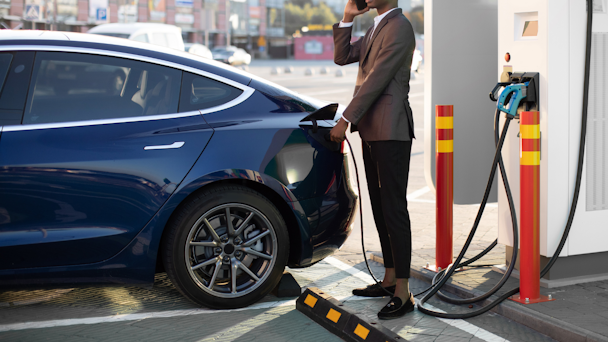Gas prices are surging post-Ukraine invasion. Is this the EV market’s big break? Maybe not.
As gas prices spike, consumers are expressing greater interest in hybrid and electric vehicles (EVs). But economic conditions including supply chain delays, semiconductor shortages and the ‘unprecedented’ inflation of nickel costs associated with Russia’s new commodities export ban stand to hurt EV adoption rates everywhere.

Consumer consideration of EV adoption is growing, but supply chain shortages and rising material costs could hamper sales growth / Adobe Stock
Spurred by post-pandemic market rebounds and exacerbated by an influx of economic sanctions being levied against Russia in the wake of Putin’s invasion of Ukraine, gas prices are surging around the world. Combined with growing consumer demand for hybrid and electric vehicles, the automotive industry would seem poised for an overhaul. But a variety of economic factors are hindering the transition.
Consumer interest in sustainable alternatives to traditional gas-fueled cars is growing rapidly, according to new data from Edmunds, a leading online automotive shopping resource. Shoppers’ consideration of hybrid, plug-in hybrid and battery-powered electric vehicles on the site – which sees 20m online visits monthly – jumped 39% over the past month and increased 18% between February 27 and March 6. Spikes like these suggest that consumers, wary of high gas costs associated with Russia’s invasion of Ukraine and rising inflation, are increasingly considering switching over to greener models.
But consumer consideration and positive sentiment aren‘t translating to sales. In fact, experts aren’t convinced that temporary inflation will have an imminent effect at all.
“Near-term gas price spikes or inflation is likely to have little impact on [the EV market],” says Ram Chandrasekaran, principal analyst at Wood Mackenzie, a New York-based consultancy and market research firm focused on the renewables sector. Inflation writ large, he argues, deters consumers from making such large investments as new car purchases.
Chandrasekaran isn’t the only skeptic; his assessment is echoed by Corey Cantor, an analyst on the EV research team at BloombergNEF, the new energy technology research arm of Bloomberg. “There’s kind of this weird tension ... which is that the total cost of ownership might be getting more attractive ... but upfront prices [remain high].” High upfront costs of EVs are due in part to ongoing supply chain issues. For one, automakers of all types are still grappling with a global semiconductor shortage.
Japanese carmaker Nissan, like many of its competitors, has been affected by low chip supply. In recent years, the company has invested significant capital in EV development (in February shelling out millions for a star-studded Super Bowl spot promoting its all-electric 2023 Nissan Ariya) and plans to electrify 40% of total sales by 2030. But as it stands, semiconductor shortages counteract any potential upticks in sales, says Ross Proffitt, the brand’s chief marketing manager of electric vehicle marketing and sales.
“While there is usually a general correlation tied to rising gas prices and electric vehicle consideration, availability is not optimal right now due to the microchip shortage, and we have no way of predicting how long the fuel prices will stay elevated,” Proffitt says.
On top of these issues, other economic movements are likely to hamper EV adoption rates around the world. Commodities price inflation – particularly of lithium and metals such as nickel – impedes manufacturers’ ability to produce batteries, and therefore battery-powered electric vehicles, affordably.
In the past few days, nickel prices have hit record highs. The London Metal Exchange Tuesday decided to cease trading for a number of days after nickel prices more than doubled, reaching $100,000 per metric tonne – a surge that Guy Wolf, global head of market analytics at energy and commodities broker Marex, called “unprecedented.” The spike was catalyzed by Russia’s invasion of Ukraine in late February and has been exacerbated by the Kremlin’s ban on commodity exports – a decision made in reaction to economic sanctions imposed by the US and other countries.
Many of the metals needed to manufacture EV batteries are sourced from the region. Russia maintains 7.5m metric tonnes of metal in reserves and last year produced 9.2% of the world’s total mined nickel, per data from the US Geological Survey. The country’s commodity ban is sure to serve a major blow to EV battery manufacturing operations across the globe.
Advertisement
The future is greener than ever
All things considered, ballooning gas costs and growing consumer consideration aren’t enough to move the needle on hybrid and EV adoption at this moment in time.
Longer-term trend lines, however, tell a different story. Year-on-year, EV and hybrid adoption is still expected to grow significantly.
“EV sales will take another leap in 2022,” says Wood Mackenzie’s Chandrasekaran, who predicts that in 2022, global EV sales will reach 9.3m – up from more than 6m in 2021 (estimates range between 6.2m-6.6m).
As it stands, China and Europe have seen the highest rates of EV adoption among the general public. But markets around the world are catching up. “The number of EV models will expand in almost all regions,” Chandrasekaran predicts.
Aside from rising consumer demand for more sustainable options, automakers have other incentives at play; chief among them are tightened fuel economy regulations set by the US Environmental Protection Agency (EPA) slated to go into effect in 2023. In response to the change, US automakers are ramping up EV production in order to meet more stringent emissions guidelines. Experts have suggested that in the coming year-plus, major economies around the world will be able to make EVs more profitable and ultimately accelerate the shift.
Driving the transition further are recent commitments to phase out traditional gas-powered vehicles by 2040 made by a handful of countries at Cop26, the 26th United Nations Climate Change conference held in Glasgow last fall. “Internal combustion engine vehicle sales have already entered a state of terminal decline,” says Chandrasekaran.
Advertisement
Many automakers are already reaping the rewards: even Hyundai, a relative latecomer to the EV game, is doing big numbers. The carmaker, whose recent ad starring Jason Bateman has garnered over 83m YouTube views, has seen sales of hybrid, plug-in hybrid, electric and fuel cell vehicles grow 276% in 2022 thus far. The new Hyundai IONIQ 5 was among the best-selling mainstream all-electric SUVs in February. “Hyundai is no longer one of the followers in the automotive industry, but is taking the leap to become a game-changer,” the brand‘s chief marketer Angela Zepeda tells The Drum.
At the company’s 2022 CEO Investor Day forum last week, chief executive Jaehoon Chang spelled out the company’s electrification strategy through 2030 – a plan that includes 17 new battery-powered electric vehicles. Chang said that Hyundai will invest almost $80bn in new hardware and software technologies to achieve its goal of capturing 7% of the global EV market by 2030 (it currently owns an estimated 2.3%).
Tesla, helmed by billionaire Elon Musk, remains the definitive category leader, with 14% of the world’s total EV market. In the US, the California-based automaker controls a staggering 79% of the market. Other key industry players include Volskwagen, BMW, Nissan and Chevrolet.
Ultimately, things are on the right track, says Nissan’s Proffitt. “We are seeing more consideration for electric vehicles than we have before, and that is evident in the number of new EVs hitting the market. Consumer interest will continue to evolve as more sustainable models become available at an affordable price point in an attractive package.”

